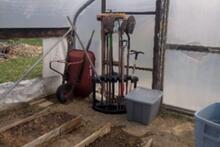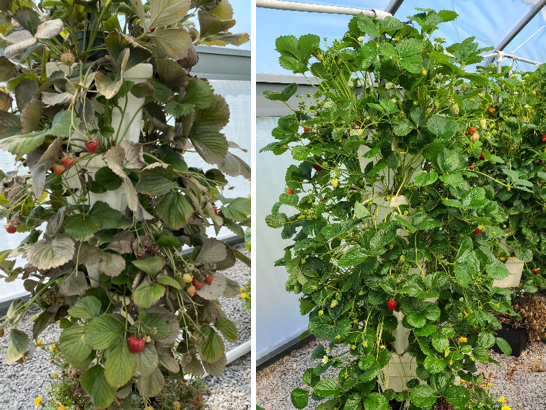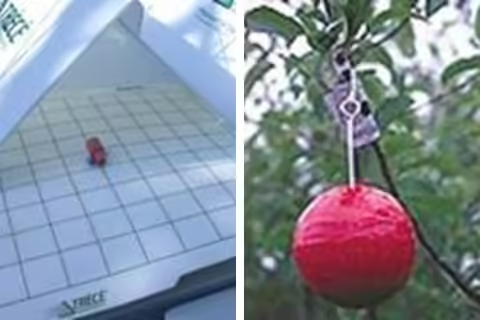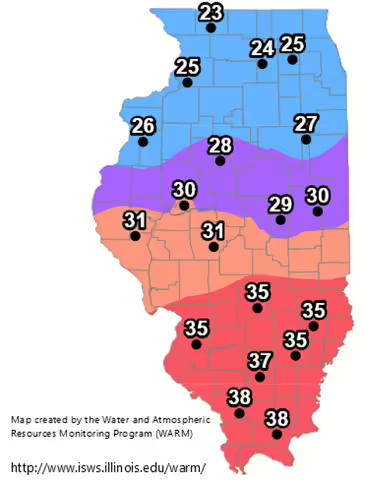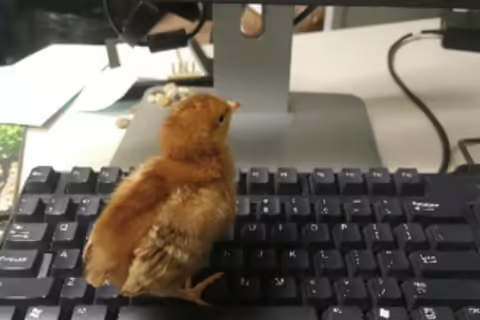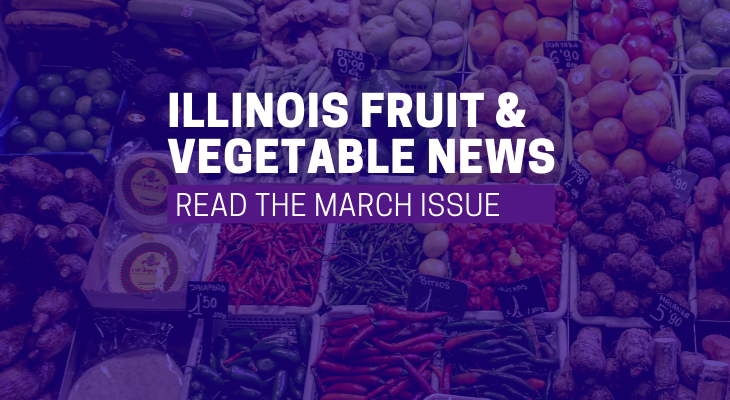
Survey for Commercial Apple Growers on Adoption of New Sprayer Technology
We are conducting a survey of commercial apple growers to learn about your experiences in managing pests and diseases on apples, and your willingness to adopt a new sprayer technology that is currently being marketed as the “Intelligent Sprayer.” The Intelligent sprayer uses lasers to direct pesticide sprays more precisely and efficiently than traditional airblast sprayers.
This sprayer was developed at Wooster, Ohio, by a team of USDA-ARS engineers. Our USDA-funded study, which runs from 2020 through 2022, is evaluating the use of Intelligent Sprayer in the eastern half of the U.S. for control of the full range of pests and diseases on apples. You can participate in this survey even if you haven’t heard of or tried this new sprayer.
Your participation in this survey is voluntary. Your responses are valuable to us and will contribute to bringing precision ag advances into apple IPM spraying for many apple growers. Here's your access to the survey.
The responses you provide will be kept completely confidential, and results will be reported in a summary form only. Please answer the questions by clicking on a response option or entering text in the box. You will have an opportunity to add comments at the end of the survey.
Thank you in advance for your time and attention!
Dr. Mark Gleason, Professor of Plant Pathology, Iowa State University, mgleason@iastate.edu, 515-294-0579
Dr. Melanie Ivey, State Fruit Pathologist, Ohio State University, ivey.14@osu.edu, 330-263-3849
Dr. Heping Zhu, Lead Scientist, USDA-Agricultural Research Service (ARS) Application Technology Research Unit, Wooster, OH, heping.zhu@usda.gov, 330-263-3871
Survey for Cucurbit Growers on Adoption of Mesotunnels
We are conducting a survey to learn about your experiences using row covers and your willingness to adopt a new row cover approach known as mesotunnels. Our study is evaluating the use of mesotunnels in the eastern half of the U.S. for control of the full range of pests and diseases on organic production of cucurbit crops.
Your participation in this survey is voluntary. You may not have used mesotunnels or row cover systems in your production, that is perfectly fine and we still value your opinions. Your responses are valuable to us and will contribute to improving row cover innovations. Here's your access to the survey.
The responses you provide will be kept completely confidential, and results will be reported in a summary form only. Please answer the questions by clicking on a response option or entering text in the box. You will have an opportunity to add comments at the end of the survey.
Thank you in advance for your time and attention!
Dr. Ajay Nair, Associate Professor of Horticulture, Iowa State University, nairajay@iastate.edu, 515-294-7080
Dr. Mark Gleason, Professor of Plant Pathology, Iowa State University, mgleason@iastate.edu, 515-294-0579
Small Farms Winter Webinar Series Recordings Available
The Local Foods and Small Farms Team has wrapped up our popular Small Farms Winter Webinar Series for 2022. We thank those that have attended and been a part of the series this year. In March, these weekly webinars have included vermicomposting, mushroom production, backyard swine, and grapes. All previous webinars are recorded and can be accessed on our YouTube channel.
To compliment these webinar topics, we have created “Deeper Dig” videos that allow for Extension educators to have conversations with some of the webinar presenters. These videos answer questions that we were unable to answer during the webinar along with having thorough conversations on topics such as marketing, research, production, and regional impacts. Currently, we have pumpkin production and pawpaws available with more videos on high tunnel winter greens, backyard swine, and grapes to come in the next couple of months.
Grant McCarty, 815-235-4125; gmccarty@illinois.edu
St. Louis Metro East Regional Report
Although the landscape is still mostly winter bare, there are signs of the coming spring. Bare soil at 4” has reached 55°F. The two-week forecast is not showing any freeze alerts, with daytime highs mostly in the 60s and lows in the upper 30s to low 50s. Grass is beginning to green, and daffodils are beginning their bloom. Greenhouses and high tunnels are filling up with pepper and tomato transplants intended for field plantings, as well as hanging baskets for retail sales. The region came through a freeze event that resulted in temperatures dropping to the low to mid-teens the morning of March 12, but no reports of damage have been reported due to the earliness of the event.
Save the date
It may only be March, but it’s time to reserve your hotel room if you plan to attend the 2022 Great Lakes Expo in Grand Rapids Michigan from December 6-8. The Amway Grand Plaza Hotel (616-774-2000) and the Courtyard by Marriott Downtown (616-242-6000) are both connected through an enclosed walkway system to the DeVos Place Convention Center, and because of that. convenience and proximity, both tend to sell out well before the conference registration itself opens.
The Illinois State Horticulture Society extends an invite to its Summer Horticulture Day on June 9 at Eckert’s Family Farm in Belleville. Stay tuned for future updates as they become available.
Elizabeth Wahle, 618-344-4230; wahle@illinois.edu
Southwestern Illinois Regional Report from Waterloo
It is starting to feel like spring in southern Illinois! We are still in our typical March rollercoaster of temperatures but have seen a few days up to 80°. In the last few weeks things have been modestly warm with highs ranging from 50° on up to about 80°. Over the past weekend (3/19-20) we did have lows down in the mid-30s but did not have any frost. Earlier in March we did get 1.7” of rain and then a very small amount of snow which included some temperatures down in the teens for lows. Fortunately, we had not had much warm weather prior so most perennial crops did not sustain much damage that I have observed from those low temperatures. Saturday (3/19) we did get 0.4” of rain, but prior to that, soil conditions were relatively dry for this time of year. Even now after that rain, the sun and wind have dried at least the soil surface.
Out in the field, things are finally are starting to green up. Field conditions have been good for some late-winter cleanup and maintenance on perennial crops. I was able to prune tree fruit at home on the farm and also recorded a short video of my pruned blueberries, with a few considerations to keep in mind during the pruning process. Soil conditions were good, so that many cool season vegetables were able to be planted like, peas, lettuce, spinach and radishes. I had a small area where I snuck in an early March planting of some lettuce, peas, and turnips that are now starting to emerge, and before this last rain, I planted some more along with a few carrots. I had overwintered some spinach under a low tunnel, and over the last few weeks. the growth on it has increased rapidly, now harvesting leaves a couple times a week. I also was able to do some rough tillage for potatoes and some early sweet corn to go in closer to April.
Hopefully, spring weather will be kind to us from here as we get a start to the 2022 growing season!
Nathan Johanning, 618-939-3434; njohann@illinois.edu
Southern Illinois Regional Report from Murphysboro
It’s officially spring! We kicked off March at the Jackson County office with a high tunnel cleaning party that was probably overdue, but the picture is a reminder that it was worth the effort. Starting with a clean and organized space makes the rest of the growing season that much easier. We have also taken this time to solarize the oats planted in the beds and the photo shows the dead growth, indicating the process successfully terminated the winter cover crop. Soil levels in the beds will be assessed to determine if they need to be topped off with compost. The current 10-day forecast is only calling for one day with a low near freezing; fingers crossed that it stays that way.
Outside of the high tunnel we are starting to prepare ourselves for spring planting. The asparagus has been sprayed with a pre-emergent herbicide to control weeds through-out the season. We have planted some snow peas in our raised beds and are planning to add some other spring veggies to the mix. Earlier this month I also pruned the blackberries and we will be re-mulching them with straw.
As always have a safe and fun Spring!
Katie Bell, 618-687-1727; klbell@illinois.edu
Dixon Springs Ag Center Regional Report
Hopefully, everyone has been able to take advantage of our warmer temperatures and somewhat drier conditions. We did not receive as much rain as was predicted for our area. We were prepared to reskin the middle high tunnel last week, and in watching the forecast and observing site conditions on Thursday, we moved forward with our plan. The process was going smoothly, with the south endwall secured, but about halfway through securing the north endwall, the wind suddenly kicked up and changed direction. Needless to say, the plastic ripped along the wiggle wire channel and became unusable for that tunnel. New plastic has been ordered and we will try again. It is always challenging to find the perfect conditions to reskin these high tunnels, especially during the windy, kite flying days of March!
Strawberries have been planted in the vertical stacks in the hydroponic tunnel, and we will be placing the predatory mites, Phytoseiulus persimilis, in these hydroponic strawberries. This species is generally considered the most effective spider mite predator. They are very specific. Last year we had quite a spider mite infestation in the strawberries while we were using a more general predatory mite, Amblyseius swirskii, that targets thrips, whiteflies, and spider mites. It was not particularly effective in the strawberries the way we were using it. We were using a product that allowed us to pour the predatory mites directly on the plant. Halfway through the growing season, we switched to the Phytoseiulus persimilis, and the infestation was cleared up within a few weeks and the photo shows how well the strawberries bounced back. This year, we are adding the predatory mites to the strawberries upon transplant to try to take care of the spider mite problem before it begins. We will keep you posted on our progress!
Kacie Athey, 217-244-9916; kathey@illinois.edu
Bronwyn Aly, 618-695-2441; baly@illinois.edu
Understanding the Physiology of Fruit Thinning and Available Online Tools
Adapted and edited by Elizabeth Wahle from article originally submitted by Mosbah Kushad, IFVN 18:1, 2012
As most of you know, thinning is not an exact science. There are many factors that can make a thinning chemical work effectively and others that make it less effective. Dr. Alan Lakso, Emeritus at Cornell University developed a carbohydrate balance model for apples which is now available as a tool on the NEWA (The Network for Environment and Weather Applications, Cornell University) platform. The model is based on supply and demand for energy-rich carbohydrates by the tree. During times of high supply and low demand (sunny and cool), the balance is positive, and it is difficult to thin chemically. When the balance is slightly negative, chemical thinning becomes easier. When the balance drops to a critical limit, the trees are under significant carbohydrate stress, and chemical thinning will be strong. Below a critical limit, the natural stress may be so severe that some fruits will be shed even when thinners aren't used because the response to chemical thinners is predicted to be very strong.
In general, tree physiology and environmental conditions are the two major factors affecting the response of most chemical thinners. The physiological factors in the tree that affect thinning response include variety, tree age, tree health, crop load, and severity of pruning. A weak and a very old tree is relatively easier to thin than a healthy and young tree. Similarly, a heavily cropped tree is relatively easier to thin than a lightly cropped tree. However, you should know that even though the chemical may have knocked a large number of fruit off the tree, you may still have more fruit left due to poor chemical coverage, making it a better management practice to monitor the number of the fruits that are left on the tree, not those on the ground.
Another factor that contributes greatly to the effectiveness of a thinner is the variety. For example, 'Fuji' fruits are harder to thin than 'Gala' fruits. The type of tree is also important; for example, 'Spur' varieties are harder to thin than non-spur varieties. Some studies also suggest that pruning may have an influence on the effectiveness of thinning.
Application timing is also important. Some thinners work best when applied at bloom time. But this has generally been a time when growers prefer not to apply thinners because of the uncertainty of late spring frost. However, early thinning plays an important role in return bloom, especially in biennial bearing cultivars like Honeycrisp and Fuji. The apple pollen tube growth model was developed at Virginia Tech to help apple growers more precisely time thinning sprays during bloom and is also available as a tool on the NEWA platform for Fuji, Gala, Golden Delicious, Granny Smith, Honeycrisp, Red Delicious, and Pink Lady. For more information on how this model works, see Penn State’s March 26, 2019 article on Apple Crop Load Management: Blossom Thinning Apples with Lime Sulfur
Penetration of the chemical thinner is greater through the lower side of the leaf than the upper side, and these differences increase as the leaves age because older leaves have more wax deposited on the upper surface than the lower surface. Interestingly, very little NAA enters the plant leaf through the stomates and instead most enters through active transport channels across the plasmalemma. In other words, the leaves spend energy to get NAA inside so it can cause the fruit to abscise. A tree that has heavy bloom will require a significant amount of energy to take up the thinner, and so it is advisable to supplement the tree with some nitrogen at bloom to offset the amount of energy spent on producing the flower and getting rid of the fruit during thinning.
Environmental factors also have a strong influence on the effectiveness of thinning chemicals. Ed Stover and Duane Green published a very nice review in Hort Technology on the effect of environment on the performance of thinners. In this article they pointed out several pre-, during, and post-application factors that impact the effectiveness of growth regulators on fruit thinning. During the early stages of growth, leaves deposit waxes on the surface. The amount, structure, and composition of these waxes influence leaf wetness and penetration of thinning chemicals. Deposition of these waxes is affected by the environment. Low light, high humidity, frost damage, and low temperatures were listed as factors that can increase the response of thinning chemicals, while high temperature and dry conditions reduce the effectiveness of the thinning chemicals. Many of these factors work synergistically, so if the weather is warm and humid the thinning chemical will work more effectively than if the weather is cold and dry. The greatest uptake occurs right before the chemical has completely dried (because of the increase in the concentration of the chemical). However, uptake decreases drastically when the chemical has completely dried. Therefore, conditions that allow for longer drying periods will increase the effectiveness of thinning. Field studies have also shown that if the chemical droplet dries before it is washed by rain, its activity is not lost. However, if the droplet is still wet and a rain occurs, then the chemical will be less effective because it washes off before it gets into the leaf. These are only a few of the factors that impact the effectiveness of the thinning chemicals, and that is why it is difficult to predict if a thinner will work or not.
Elizabeth Wahle, 618-344-4230; wahle@illinois.edu
Monitoring Key Insect Pests in Tree Fruits Using Pheromone Traps
Apple and peach growers, it is that time of year again to order your pheromone traps for insect pest monitoring. These traps should be used through harvest to monitor for pests. Traps are useful for monitoring many insects of fruit crops, and the most important pests for Illinois growers are listed in Table 1.
What kind of traps work best?
Large plastic delta (LPD) traps work best. Several companies manufacture these traps, Trecé, Scentry, Suterra, and Alpha Scents. As a note, Trecé markets it as the Pherocon VI trap. This trap is quick to set up and easy to maintain; the sticky trapping surface is a card that slides in and out quickly and easily. If you bring the trap “shell” indoors at the end of the season, you can expect to get at least 2 to 3 years use from each trap (while replacing lures and liners as needed). Midwestern suppliers of traps include:
- Great Lakes IPM, Phone: 989-268-5693 | email: glipm@greatlakesipm.com
7563 N Crystal Rd., Vestaburg, MI 48891-9746 - Gemplers, Phone: 800-382-8473 | email: customerservice@gemplers.com
P.O. Box 5175, Janesville, WI 53547-5175
How do traps work?
Most of the insects listed in the table below are moths in their adult stage. For these moths, the trap must be baited with a pheromone lure – usually a small piece of rubber or plastic containing a synthetic blend of chemicals that is very similar to compounds used by female moths to attract males. When traps capture male moths, that indicates that females are also present, and mating and egg-laying are occurring. When ordering pheromone traps, you must order lures for the specific insect(s) you wish to monitor. Remember that although you may use the same type of trap to monitor different pests, you must use only a single lure per trap, it does not work to put lures for codling moth and dogwood borer in the same trap. Depending on the pest species, lures usually last 2 to 8 weeks (suppliers list the effective life of the lures they sell), so be sure to order enough lures for the whole season.
If you are growing apples in the northern half of Illinois, monitoring the flight of apple maggot flies is useful. Traps for apple maggot flies rely on appearance (especially the color and shape of a bright red apple) and the use of a food odor (“apple volatiles”) instead of a pheromone, and they are designed to capture female apple maggot flies ready to lay eggs on fruit. All the major suppliers of insect traps carry these kinds of traps. Growers should order the red spheres, tanglefoot, and the food lures recommended by the supplier. Apple maggot traps may be used without any food lures; spray thresholds vary based on use of food lures.
How many traps are needed for each pest species?
Guidelines often recommend at least 3 traps per pest species for any orchard up to 10 acres in size and 1 more trap for every 3 to 5 acres above 10. To monitor 50 acres of trees in 3 or 4 separate blocks, use 3 traps per block and at least 9-12 traps total … for each pest species. Always use at least 3 apple maggot traps (red spheres) per block of trees. See the table below regarding placement of traps. Check these traps and record counts in each at least twice per week.
If you have only one relatively small block of trees, you may want to order 3-trap kits available for each of the major pests. These kits generally include 3 lures per trap and since lures need to be replaced every 4 weeks, most Illinois growers will need another 2 lures per pest species per trap to get through the entire season.
If you operate an orchard larger than 10 to 15 acres, you'll need more traps, so contact a supplier and make plans to order in bulk. Long-life lures (last 8 weeks) are available for the codling moth and other species and are the best choice for almost all Illinois growers.
TABLE 1: Pheromone lures and traps available for purchase in Illinois
Crop | Pest | Area of Illinois | When to Place Traps | Where do you hang the traps
Apples | Codling Moth | Statewide | Bloom | Upper third of canopy, spaced throughout the block, including one somewhere near the upwind edge and one near the downwind edge.
Apples | Dogwood Borer | Statewide | Petal Fall | 4 feet above the ground and within the tree canopy. (This height is very important, 1 foot higher or lower reduces attractiveness.)
Apples | Apple Maggot | North of Springfield | June 1 | In the outer portion of the canopy of trees on the edge of the block. VERY visible to adults flying into the block (remove foliage around the sticky red spheres). Hang in border rows or end trees nearest any woods or brush outside the block.
Apples | Oriental Fruit Moth | Southern Illinois | Bloom | Upper third of canopy, but do not exceed 6-8 feet above ground.
Peaches | Lesser peach tree borer | Statewide | Bloom | Upper third of canopy, but do not exceed 5-6 feet above ground.
Peaches | Peachtree borers | Statewide | May 15 | Upper third of canopy, but do not exceed 3-4 feet above ground.
Peaches | Oriental fruit moth | Statewide | Green tip to pink | Upper third of canopy, but do not exceed 6-8 feet above ground.
Warm Winter Weather Sets the Stage for Corn Flea Beetles and Stewart’s Wilt
Average winter temperatures in Illinois this past winter shown in Figure 1 were very similar to what we saw during the winter of 2020-2021. Warmer temperatures during the months of December, January and February favor increased survivability of the corn flea beetle and subsequently, the early season prevalence of Stewart’s Wilt, particularly in the southern half of the state.
Corn flea beetles are the primary vector of Stewart’s Wilt. Erwinia stewartii, the bacterium that causes Stewart’s wilt, survives the winter in the gut of the corn flea beetle and the survival of the corn flea beetle is dependent on winter temperatures. Warmer winters result in greater survivorship of corn flea beetles, thus increasing the potential for Stewart’s wilt, while colder temperatures adversely affect it. Using the average temperatures of December, January, and February, the potential for Stewart’s wilt can be predicted. Information shared in Table 1 and the corresponding map in Figure 2 provides the projected risk of Stewart’s wilt based on those averages for locations across Illinois.
| Average temperature of December, January, & February | Probability of early season wilt | Probability of late season blight |
|---|---|---|
| <27º F | Absent | Trace at most |
| 27º - 30º F | Light | Light to Moderate |
| 30º - 33º F | Moderate | Moderate to Severe |
| >33º F | Severe | Severe |
Table 1. Projected risk of Stewart’s wilt based on the average temperatures of December, January, and February.
Corn flea beetles become active in the spring when temperatures rise above 65°F, and they feed on and transmit Stewart’s wilt bacteria to seedling corn plants. The bacterium can spread systemically throughout the plant. Although most commercial field corn hybrids are resistant to Stewart’s wilt, the disease is still a concern for susceptible seed corn inbreds and many sweet corn hybrids.
Table 2. Early season Stewart’s wilt predictions, 2022
| Location | Average temperature December 2021-February 2022 | Early Season Wilt |
| Freeport | 23° F | Absent |
| DeKalb | 24° F | Absent |
| Monmouth | 26° F | Absent |
| Peoria | 28° F | Light/Moderate |
| Champaign | 30° F | Light/Moderate |
| Springfield | 30° F | Moderate |
| Newton | 35° F | Severe |
| Belleville | 35° F | Severe |
| Mt. Vernon | 37° F | Severe |
| Carbondale | 38° F | Severe |
| Dixon Springs | 38° F | Severe |
There are two phases of Stewart’s wilt: the seedling wilt phase and the leaf blight phase. The seedling wilt stage occurs when seedlings become infected at or before the V5 stage. The vascular system becomes plugged with bacteria, causing the seedling to wilt, become stunted, and die. Infections of older corn plants usually result in the development of the leaf blight phase of Stewart’s wilt. This phase is characterized by long, yellow to chlorotic streaks with wavy margins along the leaves. When the late infection phase or “leaf blight phase” of Stewart’s wilt occurs after tasseling, it is generally not a concern in sweet corn because ears are harvested before damage occurs.
Based on the recent winter temperatures from the Midwest Regional Climate Center, estimates of early season Stewart’s wilt are shown in Table 2. Remember, however, that these are only predictions; numbers of surviving corn flea beetles are not known.
Kelly Estes, 217-333-1005; kcook8@illinois.edu
An Active February Finishes Climatological Winter
Climatologically, February is the second coldest month statewide after January. Much like January, February temperatures also tend to be quite variable day to day.
Temperatures averaged 28.0°F, 3.1° below the 1991-2020 normal for February. February average temperatures ranged from the low 20s in northern and north-central Illinois to the high 30s in far southern Illinois, between 1 and 6 degrees below the 1991–2020 normal. Several stations saw daily high temperatures in the high 60s in mid-February, including 67 degrees in Alexander and Pope Counties. Meanwhile, stations in northern and central Illinois saw nighttime low temperatures well below 0, including -9 degrees in Knox County and -8 degrees in Woodford County.
Precipitation statewide in February was 3.10 inches, 0.99 inches above the long-term statewide average. Total February precipitation ranged from less than 1 inch in far northwest Illinois to over 9 inches in parts of southern Illinois. Last month was about 1 inch drier than normal in northwest Illinois, 1 to 2 inches wetter than normal in central Illinois, and 4 to 7 inches wetter than normal in southern Illinois. Two observers near Cobden in Union County measured more than 9 inches of rain in February, one of the top 20 highest February totals on record statewide. Meanwhile, several stations in northwest Illinois recorded less than three-quarters of an inch of precipitation for February, including 0.63 inches in Freeport and 0.57 inches in Stockton.
Snow: After a very slow start to winter, much of the state finally saw considerable snowfall in February. A series of winter storms in early to mid-February brought several rounds of moderate to heavy snowfall, with the highest totals along and around the Interstate 55 corridor from St. Louis to Chicago. Overall, February total snowfall ranged from less than 4 inches in southern and far northwest Illinois to over 20 inches in parts of central and northeast Illinois. February snowfall was 2 to 4 inches below normal in drought-stricken northwest Illinois, within 2 inches of normal in northeast and southern Illinois, and 6 to 12 inches above normal from the St. Louis Metro East through central Illinois into the southern Chicagoland area.
Drought: February precipitation patterns reinforced a dry north-to-wet south pattern in Illinois, present since the fall. The heavy February rain and snow melt in southern Illinois has caused several spots along the Wabash and Ohio Rivers and tributaries to reach or exceed moderate flood stage. Excessively wet soils in southern Illinois also raise concerns of continued flooding risks and possible fieldwork issues as we approach the start of the growing season. Concurrently, the dry winter has not helped alleviate drought conditions across northern Illinois, as the U.S. Drought Monitor expanded or continued moderate to severe drought from Lake County to Rock Island County.
Outlooks: The latest outlooks from the Climate Prediction Center look to keep warmer and wetter conditions around statewide through the end of March and start of April. Updated April through June seasonal outlooks also show highest odds for warmer than normal conditions through the spring-summer transition, although chances of wetter conditions decrease as we move from April to June.
Trent Ford, Illinois State Climatologist, 217-244-1330; twford@illinois.edu
Less Seriously
How do chickens type?
They hunt and peck
Check out this super cute little peeper that hatched last week and is hoping to land a summer internship with Katie Bell!
Upcoming Events
Annie’s Project Training Program: 6 weekly sessions starting February 24 at the Jackson County Extension Office, Murphysboro, IL. Annie's Project brings women together to learn from experts in production, financial management, human resources, marketing, and the legal field. The program covers many topics dedicated to strengthening women's roles in modern farm and ranch enterprises, including business plans, crop insurance, diversifying farm operations, estate planning, farm appraisal, and much more. Interested participants can learn more or register at go.illinois.edu/anniesproject2022 or by contacting Katie Bell at 618-687-1727 or klbell@illinois.edu
University of Illinois Extension Fruit and Vegetable Specialists
Extension Educators – Local Food Systems and Small Farms
- Bronwyn Aly: Gallatin, Hamilton, Hardin, Pope, Saline, & White Counties | 618-695-2441 | baly@illinois.edu
- Katie Bell: Franklin, Jackson, Perry, Randolph, & Williamson Counties | 618-687-1727 | klbell@illinois.edu
- Sarah Farley: Lake & McHenry Counties | 847-223-8627 | sfarley@illinois.edu
- Nick Frillman: Woodford, Livingston, & McLean Counties | 309-663-8306 | frillma2@illinois.edu
- Zachary Grant: Cook County | 708-679-6889 | zgrant2@illinois.edu
- Doug Gucker: DeWitt, Macon, & Piatt Counties | 217-877-6042 | dgucker@illinois.edu
- Erin Harper: Champaign, Ford, Iroquois, & Vermillion Counties 217-333-7672 | harper7@illinois.edu
- Grace Margherio: Jackie Joyner-Kersee Center, St. Clair County | 217-244-3547 | gracem@illinois.edu
- Grant McCarty: Jo Daviess, Stephenson, & Winnebago Counties | 815-235-4125 | gmccarty@illinois.edu
- Katie Parker: Adams, Brown, Hancock, Pike & Schuyler Counties | 217-223-8380 | keparkr2@illinois.edu
- Kathryn Pereira: Cook County | 773-233-2900 | kpereira@illinois.edu
Extension Educators – Horticulture
- Chris Enroth: Henderson, Knox, McDonough, & Warren Counties | 309-837-3939 | cenroth@illinois.edu
- Richard Hentschel: DuPage, Kane, & Kendall Counties 630-584-6166 | hentschel@illinois.edu
- Andrew Holsinger: Christian, Jersey, Macoupin, & Montgomery Counties | 217-532-3941 | aholsing@illinois.edu
Extension Educators – Commercial Agriculture
- Elizabeth Wahle: Fruit & Vegetable Production | 618-344-4230 | wahle@illinois.edu
- Nathan Johanning: Madison, Monroe, & St. Clair Counties | 618-939-3434 | njohann@illinois.edu
Campus-based Extension Specialists
- Kacie Athey: Entomology | 217-244-9916 | kathey@illinois.edu
- Mohammad Babadoost: Plant Pathology | 217-333-1523 | babadoos@illinois.edu
The Illinois Fruit and Vegetable News is a production of University of Illinois Extension and provides timely, research-based information that commercial fruit & vegetable growers can apply to benefit their farming operations.
Address any questions or comments regarding this newsletter to the individual authors listed after each article or to its editors, Nathan Johanning, 618-939-3434, njohann@illinois.edu or Bronwyn Aly 618-695-2441, baly@illinois.edu.
To receive or be removed from email notification of new postings of this newsletter, contact Nathan Johanning or Bronwyn Aly.
Download a Print Version of the Newsletter
Want to share the newsletter with others? Download a print version to read and share.
